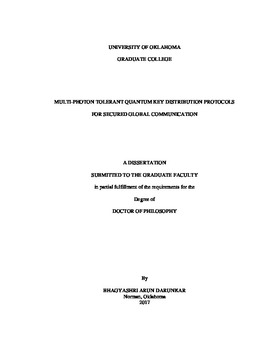| dc.contributor.advisor | Chan, Kam Wai Cliff | |
| dc.contributor.author | Darunkar, Bhagyashri | |
| dc.date.accessioned | 2017-08-03T18:23:18Z | |
| dc.date.available | 2017-08-03T18:23:18Z | |
| dc.date.issued | 2017-07 | |
| dc.identifier.uri | https://hdl.handle.net/11244/51892 | |
| dc.description.abstract | This dissertation investigates the potential of multi-photon tolerant protocols for satellite-aided global quantum key distribution (QKD). Recent investigations like braided single-stage protocol and the implementation of the three-stage protocol in fiber have indicated that multi-photon tolerant protocols have wide-ranging capabilities for increasing the distance and speed of quantum-secure communication. This dissertation proposes satellite-based network multicasting and its operation that can profitably use multi-photon tolerant protocols for quantum-secure global communication.
With a growingly interconnected world and an increasing need for security in communication, communication satellites at Lower Earth Orbits (LEO), Medium Earth Orbit (MEO) and Geostationary Earth Orbit (GEO) have a potential role in serving as a means to distribute secure keys for encryption among distant endpoints. This dissertation systematically evaluates such a role. The dissertation proposes a layered framework using satellites and fiber optic links that can form a composite system for carrying the information payload and distributing quantum-secure keys for encrypting information in transit.
Quantum communications links are currently point-to-point. Considering the concept of global QKD network, there is need for multicast quantum links. Multi casting can be achieved in quantum networks by (a) using multiple wavelengths, or (b) using use specific set of bases. In efforts to develop a composite quantum secure global communication system; this dissertation also introduces the concept of multi-photon tolerant quantum threshold cryptography. The motivation for development of threshold cryptography is that a secret can be encrypted with multiple users and requires multiple users to decrypt. The quantum threshold cryptography is proposed by using idea of multiple bases. This can be considered as step forward towards multiparty quantum communication. This dissertation also proposed layered architecture for key distribution.
Concisely, this dissertation proposes the techniques like multicasting in quantum scenario, quantum threshold cryptography to achieve the goal of secured global communication. | en_US |
| dc.language | en_US | en_US |
| dc.subject | Engineering, Electronics and Electrical. | en_US |
| dc.subject | Quantum cryptography | en_US |
| dc.subject | Secured communication | en_US |
| dc.subject | optical cryptography systems | en_US |
| dc.subject | Quantum Key Distribution | en_US |
| dc.subject | Global Communication | en_US |
| dc.title | MULTI-PHOTON TOLERANT QUANTUM KEY DISTRIBUTION PROTOCOLS FOR SECURED GLOBAL COMMUNICATION | en_US |
| dc.contributor.committeeMember | Verma, Pramode | |
| dc.contributor.committeeMember | Kak, Subhash | |
| dc.contributor.committeeMember | MacDonald, Greg | |
| dc.contributor.committeeMember | Ray, William | |
| dc.date.manuscript | 2017-07-31 | |
| dc.thesis.degree | Ph.D. | en_US |
| ou.group | College of Engineering::School of Electrical and Computer Engineering | en_US |
